Introduction
Sola Sound’s original Tone Bender fuzz box from 1965, nowadays given the ‘MKI’ designation, was one of the very first commercial effects pedals available in England. The ‘MKI’ was designed & built by Gary Hurst, and sold predominantly in central London at a time when pop music was thriving, and when electric guitarists were developing new sounds. For a detailed trip into the history and the development of the ‘MKI’, please see the main article for the Gary Hurst/Sola Sound Tone Bender ‘MKI’.
The groups and artists named on this page are all supported by strong evidence for their connection with the famous early Tone Benders. This evidence includes a combination of photography & video, anecdotes & testimonies sometimes from the artists themselves, and references from the 1960s & 1970s press. One particularly valuable piece of evidence is a list of early customers that was compiled at the time by Gary Hurst, and which was graciously circulated around the D*A*M Stompboxes forum by Graham Green.
Something interesting to note is that the Tone Bender ‘MKI’ is the only vintage effects pedal (of any sort) where there are actually more confirmed examples of notable artists using the model, than there are surviving examples of the pedals. What this suggests is that the 1965 Tone Bender ‘MKI’ was disproportionately adopted by professional musicians, rather than by amateurs, compared with the various fuzz boxes that followed. Whether this is because the ‘MKI’ was simply one of the earliest around, or because of how expensive the pedal was upon release, or perhaps because of the superior sound of the ‘MKI’ to many of its contemporaries, can’t be known. Nonetheless, this unusual ratio of ‘famous users’ to extant pedals is testament to the historical significance of the ‘MKI’.
This list of artists is already fairly comprehensive, but it will continue to be updated as and when more information presents itself.
Index
The Animals


Eric Burdon & The Animals were filmed on January 7th, 1967, for the Dutch TV programme Fanclub, in an episode that aired on the 13th. In a set of photos from the broadcast, guitarist Vic Briggs can be seen playing a Fender Stratocaster through a Tone Bender ‘MKI’. (Photo credit: F. van Geelen)
While the Animals’ 1966 hit single, Don’t bring me down, featured a prominent fuzz guitar section, it is very unlikely that a Tone Bender was used for the recording of that song. This is because the Animals were regularly listed in advertisements for the WEM Rush Pep Box, in 1966, and there exists photographic evidence of then-guitarist Hilton Valentine performing with a Pep Box around the same time.
These photos are thus far the only evidence connecting the Animals with the ‘MKI’.
The Beatles

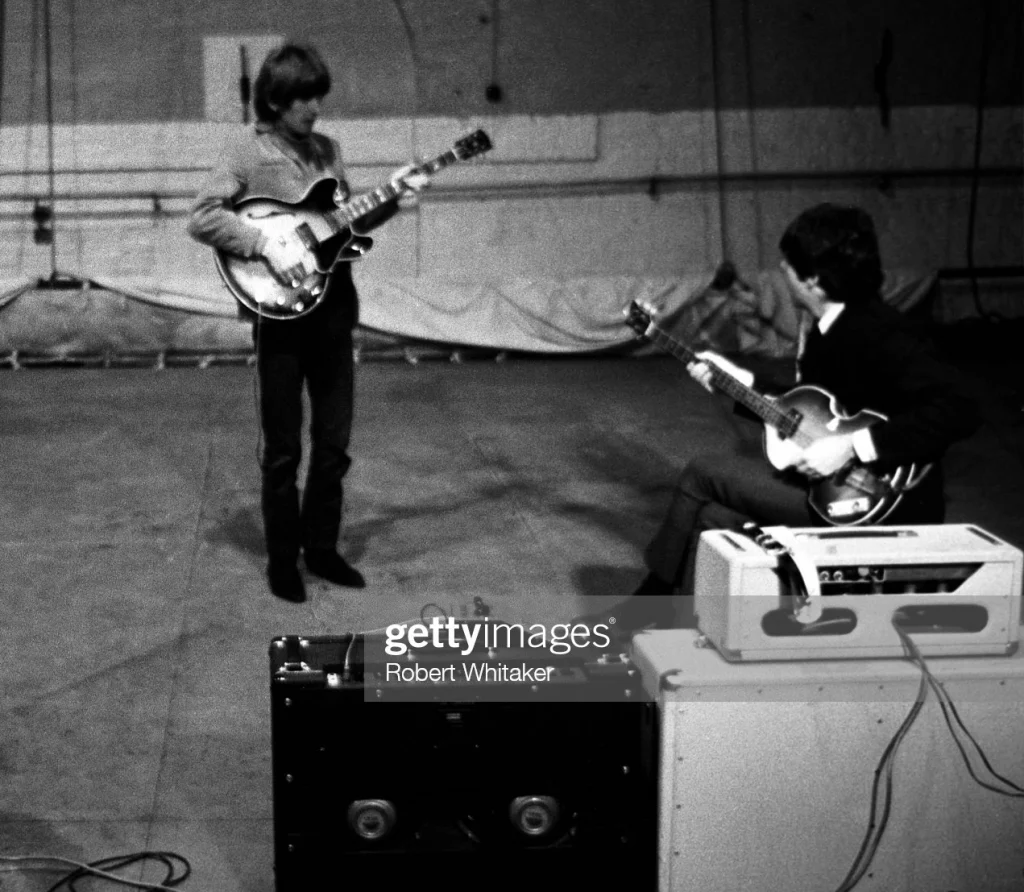

Gary Hurst recalled, in a 2010 interview, having personally delivered two Tone Benders to the Beatles during a rehearsal.1 A set of photos taken on November 20th 1965 (some of which are pictured above) corroborate Hurst’s account of events. In them, Paul and George can each be seen at various times plugged into Tone Bender ‘MKI’ pedals. Hurst, himself, is also visible in one of the pictures from the set. (Photo credit: Robert Whitaker/Getty Images)
Because these photos from the Donmar Hall rehearsal are dated several weeks after the recording session for Think for yourself, we can safely rule out the possibility that either of the two Tone Benders pictured in them might have been used for Paul McCartney’s famous fuzz-bass track.
Related links: Spotlight: The Beatles
“Big Boy Pete” Peter Miller
Singer, songwriter & producer “Big Boy Pete” Peter Miller was active in the British music scene during the 1960s. The Tone Bender ‘MKI’ can be heard on Big Boy Pete’s Flying Solo.
The above photo was taken at the NCO club of the US Air Force base in NKP (Nakon Phanom), in Northern Thailand, in July 1969. Pete’s pedal was discarded at around that time, after getting rusty from the Thai climate.2
Visible white lettering above the jack sockets on Pete’s fuzz box reveals it to have been a relatively early example of the Tone Bender ‘MKI’.
Special thanks to Peter Miller
Big Jim Sullivan
“Big Jim” Sullivan was a prominent session guitarist in the 1960s. After playing on P. J. Proby’s 1964 rendition of Hold me, Sullivan solidified his position in history as one of the very early adopters of the fuzz guitar sound.
Big Jim Sullivan was interviewed in 2009 as part of an investigation into the origins of the Tone Bender, and its disputed connection with contemporary session player, Vic Flick. Sullivan revealed that he was the one who brought a Maestro Fuzz-Tone to Gary Hurst, who was then working for Vox. The Maestro fuzz box apparently could not be improved, and it was never returned to Sullivan. Instead, Big Jim was supplied with a fuzz box in a wooden housing. Sullivan recalled acquiring a metal-bodied fuzz box shortly after that.3
The Birds
Not to be confused with Roger McGuinn’s American group with a similar name, Ronnie Wood, very early on in his career with the Birds, was an early adopter of the Tone Bender. According to Wood’s diary, he purchased a fuzz box from Macari’s on the 16th of July, 1965.4 The Birds are also named on Gary Hurst’s register of early customers.
It is very likely that Wood used a ‘MKI’ on the Birds’ 1965 single, No good without you baby, as well as on the 1966 songs, That’s all I need you for and Daddy Daddy.
Los Bravos
Los Bravos, from Spain, obtained a Tone Bender ‘MKI’ at some point in the 1960s as well. While the group appear to be performing outside England, Antonio Martinez Salas can be seen playing guitar through an early Tone Bender, and the rest of the group are also using various other pieces of British-built equipment. (Photo credit unknown)
The Carnaby
The Carnaby were named on Gary Hurst’s list of early customers. When Dave “Andy” Andrews was interviewed, his description of the Carnaby’s fuzz box was consistent with the metal-bodied Tone Bender ‘MKI’ pedals. Andy recalled the group acquiring their fuzz box in 1965 from the Selmer shop.5 The whereabouts of this fuzz box are sadly unknown.
The Carnaby may have used their ‘MKI’ on their 1965 single, Jump And Dance.
Dave Dee, Dozy, Beaky, Mick & Tich
Dave Dee, Dozy, Beaky, Mick & Tich were listed on Gary Hurst’s register of Tone Bender customers. Tich had apparently already obtained an early Tone Bender by September of 1965, when it was used for the recording of DDDBMT’s single, You make it move.6 This pedal was likely also used on the studio recordings for DDDBMT’s Hold tight, as well as Hideaway, in 1966.
The image above is a still from a 1966 episode of the German television programme, Beat-Club, where DDDBMT made regular performances. Visible on the floor is Tich’s Tone Bender ‘MKI’. This pedal was reportedly stolen at a different concert, on a later date.
David Bowie & the Spiders from Mars


Mick Ronson is one of the guitarists most famously connected with the Tone Bender ‘MKI’. He first acquired the model during the 1960s, whilst a member of the Rats in Hull, but Ronno continued using the ‘MKI’ on stage in the early 1970s as part of David Bowie’s Spider’s from Mars.
Mick Ronson believed his Tone Bender to have formerly belonged to Pete Townshend, of the Who. Ronno described in Melody Maker that Pete Townshend sold a Tone Bender to somebody at some point in the mid-1960s, and that that individual had in turn sold it to him.7 The Rats’ bass player recalled Ronno’s insistence about the pedal’s provenance at the time when they were acquainted,8 so it is quite likely that the exact Tone Bender that Mick Ronson used with the Rats, and with David Bowie’s Spiders from Mars, was one that the Who had performed with, years earlier.
Interestingly, Mick Ronson appears to have used two different Tone Bender ‘MKI’ pedals during his time with Bowie. The Tone Bender pictured at Pete Townshend’s feet in the period of 1965 to 1966 appears to have conventional features, such as black chicken head knobs. The ‘MKI’ that Ronno was pictured using in the late 1960s, with the Rats, has the same features. The second photo above, however, reveals that Mick may have apparently also had access to a much earlier version of the ‘MKI’, namely the version fitted with white control knobs and crude labelling above the jack sockets.
Related links: The Rats & The Who
Françoise Hardy
Françoise Hardy is named on Gary Hurst’s list of early Tone Bender customers. Whether this pedal belonged to a member of a backing group, or perhaps by a session player with whom she recorded, or indeed whether Hardy herself acquired a ‘MKI’, is all unknown at this point.
The Groundhogs

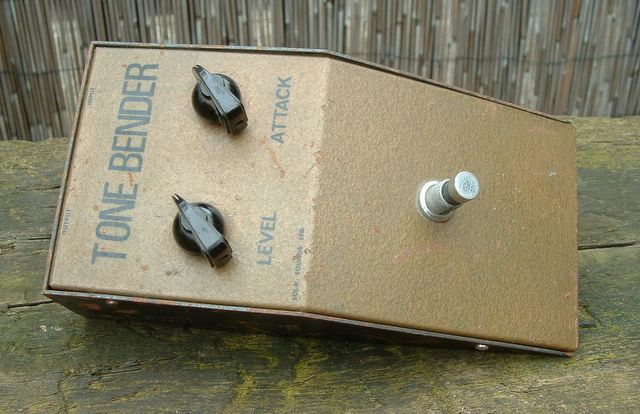
This ‘MKI’ surfaced during the 2000s, when there was very little information available about the model. The vast majority of the modern copies of the Tone Bender ‘MKI’ are based off a schematic that was drawn by David Main (D*A*M Stompboxes) from this particular exemplar. (Photo credit: D. Main)
It has changed hands several times over the years, between collectors, but this pedal’s provenance is rumoured to span to Tony McPhee, of Groundhogs fame.9
Het
At least one Tone Bender ‘MKI’ made it over to the Netherlands. Het was a Nederbeat group who released a string of singles, often with whimsical themes & lyrics, during the mid-to-late 1960s. Het are named on Gary Hurst’s list of Tone Bender customers, and so it is quite likely that a ‘MKI’ was used on their 1966 single, Kejje Nagaan.
The Inspiration
The Inspiration, from North London, were active during the late 1960s. Before going pro, Barry Stedman worked at a musical instruments showroom, where he recalled having access to different early fuzz boxes. Barry acquired his gold Tone Bender ‘MKI’ after hearing Jeff Beck using it on Heart Full of Soul.10 (Photo credit: B. Stedman)
Barry held onto his original ‘MKI’ over the course of several decades, but it was either sold, given away, or otherwise disposed of, in the early 2000s.
Special thanks to Barry Stedman
The Ivy League
The Ivy League is named on Gary Hurst’s register of early customers. The group also featured in Macari’s early advertisements for the Tone Bender.11 Currently, there is no further information about whether a Tone Bender was used by members of the group, or whether one was perhaps supplied to backing or session musicians.
Judging from the sound on the recording, a Tone Bender ‘MKI’ may have been used on the Ivy League’s 1965 B-side, Graduation day.
Jimmy Page


At the time when the Tone Bender ‘MKI’ was developed, Jimmy Page had not yet reached the sort of international fame that came as a consequence of his later work with the Yardbirds & Led Zeppelin. Nonetheless, Page was an in-demand session musician, and he was also one of the very earliest adopters of the fuzz box effect in Britain (crediting Roger Mayer for supplying him initially12).
During his tenures with the Yardbirds and (initially) Led Zeppelin, Page was photographed using grey Tone Benders in the cast aluminium enclosures (which would have likely been ‘MK1.5’ or Professional MKII models). Nonetheless, Gary Hurst also named Page as one of his early customers as well.13
There are no known photos of Jimmy Page using the conventional Tone Bender ‘MKI’ in the folded steel casing. However, on several occasions during the Yardbirds years, Page was photographed using a Tone Bender in a very early cast aluminium enclosure, painted in a particularly unusual gold finish. (Photo credits unknown)
An early gold pedal, such as the one in the Yardbirds photos above, could very well have been built using the Gary Hurst’s three-transistor Tone Bender ‘MKI’ circuitry. This is in part because an exact Tone Bender ‘MKI’ like that has actually resurfaced. Pictured below, that fuzz box even bears a very suggestive partial engraved name underneath. Unfortunately, there is no concrete evidence yet to tie this pedal to Jimmy Page, but its existence nonetheless supports the theory that Jimmy Page was also an early Tone Bender adopter.

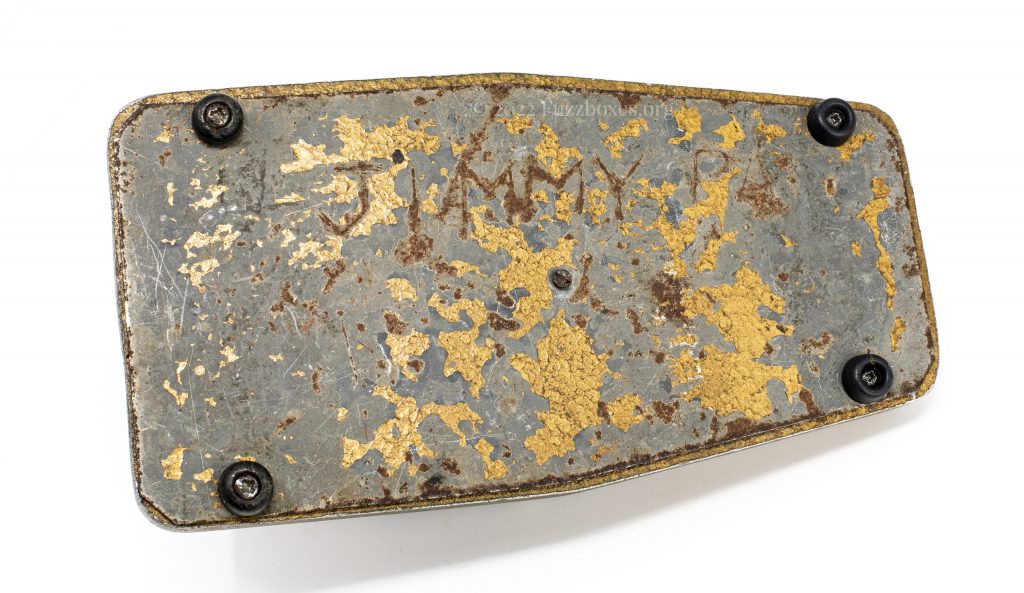
The Merseybeats
The Merseybeats, from Liverpool, are named on Gary Hurst’s register of Tone Bender customers. Merseybeats were also listed in the Tone Bender’s early press promotion.14 Nothing further is known at this time about the group’s, or of Tony Crane’s use of fuzz boxes.
Manfred Mann
Manfred Mann features on Gary Hurst’s early customer list. Hurst also recalled supplying Manfred Mann with an early Tone Bender, during a more recent interview.15
The Other Side
The photo above was taken during the filming of Jack Downing & the Other Side’s April 1966 performance for the Swedish television programme, Popside. The Other Side were a Swedish group, but at least two of the members were British, and the group were filmed using an assortment of British amplifiers. (Photo credit unknown)
Paul Thomas’ bass guitar can also be seen plugged into a Tone Bender ‘MKI’.
The Pretty Things
The Pretty Things were listed in the early Tone Bender advertisements from 1965,16 and they were also recorded in Gary Hurst’s list of early customers. Hurst also named the Pretty Things in a more recent interview, among the groups he supplied with his early fuzz boxes.17
Fuzz-guitar features prominently across the catalogue of Pretty Things recordings from the 1960s, and guitarist Dick Taylor likely had access to a number of different fuzz boxes during that period, because he was photographed in the late 1960s using a silver Arbiter Fuzz Face. As a result, it is difficult to confidently identify songs by the Pretty Things that were recorded using a Tone Bender ‘MKI’ fuzz box. Judging by the dates of the sessions, however, it is possible that the 1965 releases, Buzz the jerk and Come see me, may have featured the ‘MKI’.
The Poets
Hume Paton was photographed using a Tone Bender ‘MKI’ during a performance with the Poets, from Glasgow. (Photo credit unknown)
The Pussycats


The Tone Bender ‘MKI’ also found its way to Norway. In the mid-1960s, Pussycats’ guitarist Trond Graff took advantage of a regular ferry between Bergen and Newcastle, and brought the fuzz box back to Norway with him. Trond Graff’s Tone Bender fuzz box was used on the Pussycats’ 1966 single, Purdy patsy. Trond’s Tone Bender was discarded after a battery was accidentally left to leak inside its casing.18
Pictured above are the Pussycats during a performance on the 1st of May, 1966, with the Tone Bender ‘MKI’ visible in front of guitarist, Trond Graff. (Pussycats photo by Ukjent / CC BY-NC-ND 4.0)
Special thanks to Trond Graff
The Rondells
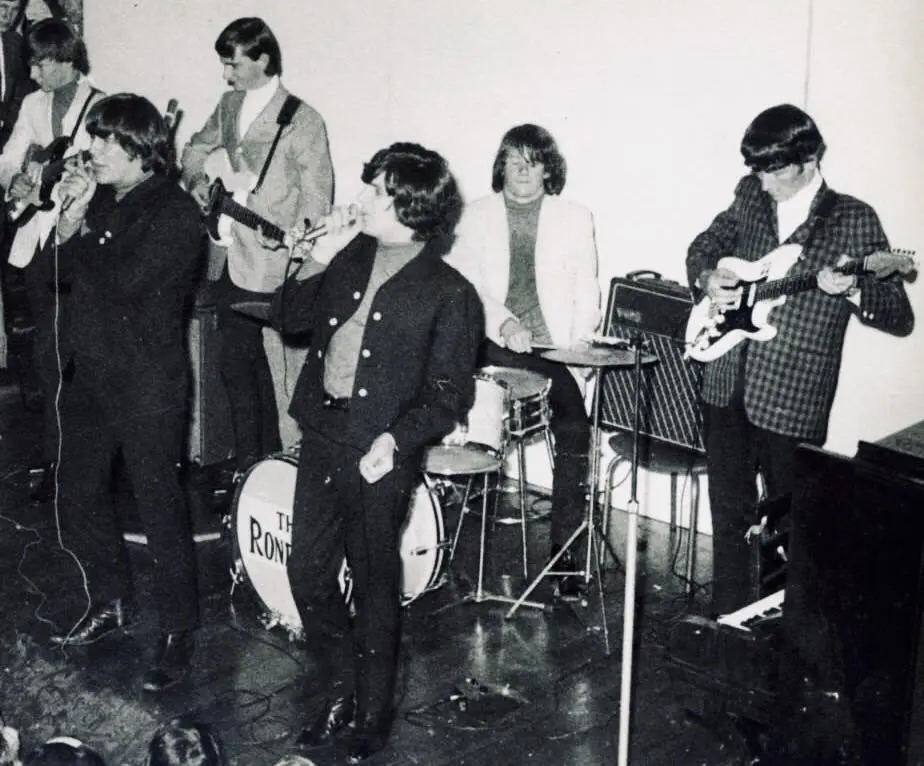

Gary Hurst’s early Tone Bender even made it to Australia. The Rondells, famously Bobby & Laurie’s backing group, obtained a ‘MKI’ from Terry Britten of the Twilights, who in turn had brought it over to Australia from England.19
The Rondells’ fuzz box was used on Bobby & Laurie’s 1966 single, Hitch hiker.
Related links: The Twilights
The Rats


Before famously joining forces with David Bowie in the 1970s, Mick Ronson played with the Rats, based in Hull. At some point during the period of 1966-1968, on a trip to London, Ronson acquired a Tone Bender ‘MKI’ that he believed to have previously belonged to Pete Townshend from the Who.
Ronno described in Melody Maker that Pete Townshend sold a Tone Bender to somebody at some point in the mid-1960s, and that that individual had in turn sold it to him.20 The Rats’ bass player recalled Ronno’s insistence about the pedal’s provenance at the time when they were acquainted,21 so it is quite likely that the exact Tone Bender in the photos above was one that the Who had performed with, roughly a couple of years earlier.
The Rats’ psychedelic original song, The rise and fall of Bernie Gripplestone, features a reversed fuzz-guitar solo, which may have been recorded using Ronson’s ‘MKI’ Tone Bender. More recently, however, it emerged that Ronno initially used a transitional ‘MK1.5’ Tone Bender during his time with the Rats, before replacing it with the famous ‘MKI’ model. Because it is not yet known exactly when Mick acquired his ‘MKI’, we cannot rule out the possibility that The rise and fall was actually recorded with a different fuzz box.
Related links: David Bowie & the Spiders from Mars & The Who
The Spencer Davis Group
Steve Winwood was filmed & photographed performing with a Tone Bender ‘MKI’ during one of the Spencer Davis Group’s appearances on Ready Steady Go!. It was reported, however, in Melody Maker that Winwood’s fuzz box was somewhat temperamental,22 and by April 1966, he was using the Tone Bender ‘MK1.5’.23
The Spencer Davis Group is listed on Gary Hurst’s register of early customers, and so it is very likely that their 1965 chart topping single, Keep on running, was recorded with an early Tone Bender.
Terje Rypdal



It is not clear when, or how, but for some reason an early Tone Bender ‘MKI’ found its way into the arsenal of eminent Norwegian jazz guitarist, Terje Rypdal. Rypdal was photographed on several occasions using the fuzz box during the 1970s. (Photo credits unknown)
This Tone Bender ‘MKI’ was seemingly also used on occasion by the bassist of Terje’s group, Sveinung Hovensjø. The cropped colour image above is a still from a 1973 performance of the Terje Rypdal Trio, with extensive use of the ‘MKI’ by Hovensjø. (Credit: ina.fr)
Tom Jones
Tom Jones is named on Gary Hurst’s register of acts that were supplied with early Tone Bender fuzz boxes. In a more recent interview, Hurst clarified more specifically that it was Mickey Gee who, in the mid-1960s played with Tom Jones’ backing group, the Senators, was supplied with an early Tone Bender. Reportedly, Gee was seeking to simulate a saxophone section.24
The Troggs
The Troggs appear on Gary Hurst’s list of early customers, and Hurst’s connection with the group was reiterated in a more recent interview.25
Songs by the Troggs from 1966, such as Lost girl and I can only give you anything may have been recorded using an early Tone Bender. There are, however, a handful of photos showing Chris Britton using a Baldwin-Burns Buzzaround during the Troggs’ live performances in the late 1960s. As a result, it cannot be said with complete certainty which, if any, of the group’s studio recordings of fuzz guitar may have utilised a Tone Bender, or whether Britton already had access to a Buzzaround as early as 1966.
The Twilights
English songwriter & guitarist Terry Britten joined the Australian group, the Twilights, at some point in the mid-to-late 1960s. In the photo above, Britten can be seen performing with the Twilights, using a British-built Vox Wah-wah pedal, as well as a Tone Bender ‘MKI’. Reportedly, Britten brought this fuzz box over to Australia with him, when he relocated. (Photo credit: Robert Davies)
Britten’s fuzz box has a particularly colourful history, in that it was also used by the Rondells, for Bobby & Laurie’s 1966 rendition of Hitch hiker.26 The same pedal can be seen in a number of photos of the Rondells on stage during the 1960s.
The Twilights photo above is dated by the photographer to 1967, and this is supported by the fact that the Vox Wah-wah in the photo wouldn’t have been available prior to that year. This creates an inconsistency with the fact that the Rondells had supposedly already recorded Hitch hiker with this exact Tone Bender in the previous year. The reason for this inconsistency is still unclear.
Related links: The Rondells
The Vigilantes
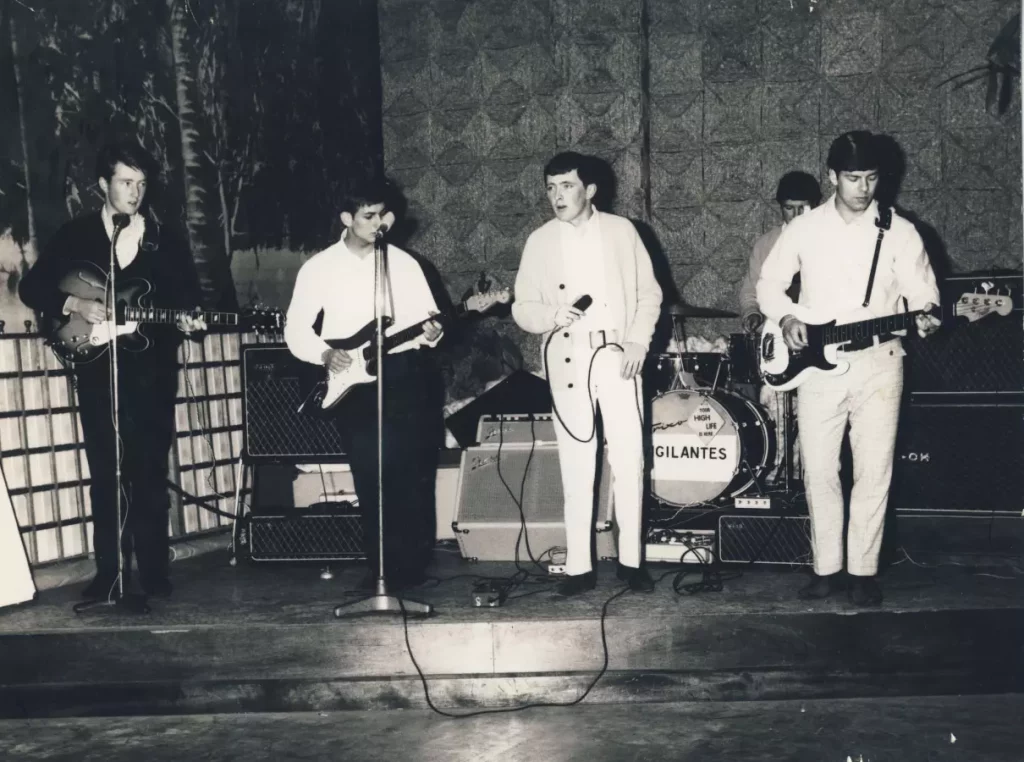

The Vigilantes were a group from Newquay, in Cornwall. The Tone Bender ‘MKI’ in the photos above was purchased in 1965 by guitarist Alan Martin, from Macari’s Musical Exchange. Alan believed it to have been built on-site by one of the engineers at the shop,27 which would presumably have been Gary Hurst. (Photo credit: Kernow Beat)
The Vigilantes’ Tone Bender ‘MKI’ behaved temperamentally, and was sadly lost over the years.
Special thanks to Alan Martin.
The Walker Brothers
The Walker Brothers were named on Gary Hurst’s list of groups that were supplied with Tone Benders. Other than that, there is no further information that has come to light yet about the group’s association with any fuzz boxes.
The Who


Pete Townshend was photographed using a large variety of different fuzz boxes during the 1960s. The Who are named on both Gary Hurst’s list of early customers, as well as in the Macaris’ advertising for the Tone Bender in 1965.28
This is corroborated by ample photographic & video evidence of Pete Townshend on stage with a ‘MKI’ Tone Bender. The photos above were taken in July & June 1966 (respectively). The black control knobs, and the layout of the lettering above them, suggests that the pedal(s) in the photos were relatively late-production examples of the ‘MKI’. Considering the Who’s extensive touring schedule at the time, and their propensity towards destroying their stage equipment at the end of a set, it is quite likely that the ‘MKI’ featured in the photos above, from mid-1966 was not the first of its kind that Townshend was supplied with, by Gary Hurst and/or Macari’s Musical Exchange. (Photo credits: Pictorial Press Limited & unknown)
One of Pete Townshend’s Tone Bender ‘MKI’ fuzz boxes reportedly fell into the hands of Mick Ronson. Mick described in an interview to have acquired his Tone Bender from a third party, who claimed that it had previously belonged to Townshend.29
Related links: The Rats & David Bowie & the Spiders from Mars
The Yardbirds
Jeff Beck was among the very first adopters of Gary Hurst’s Tone Bender. The Yardbirds featured both on Gary Hurst’s register of early customers, as well as in the Macari’s advertising for the Tone Bender in 1965. Hurst claimed that Jeff Beck was actually given a pedal, due to his association with the famous pop group. 30(Photo credit: Tony Gale/Alamy)
The Tone Bender featured heavily on the Yardbirds’ 1965 LP Having a Rave Up with the Yardbirds, as well as on numerous further recordings from the time that were included on reissues of the album. Heart full of soul has been credited as having inspired many guitarists of the 1960s to acquire their own fuzz boxes. Jeff Beck confirmed using an early Tone Bender during the recording session for Heart full of soul, in April 1965,31 which would also make the Yardbirds’ hit single the earliest known recording of a Tone Bender fuzz box.
Gary Hurst has often described how the shift in construction of the Tone Bender from wooden to metal casings came partially as a result of Jeff Beck crushing the wooden pedals on stage.
Many thanks to Philip Johnston/Pinstripedclips, Graham Green, the D*A*M Stompboxes forum, and of course to the owners of all the photos on this article.
- Shinko Music Mook, The Effector Book, vol. 7, 2010
- P. Miller (personal communication, 4th February 2012 & 25th May 2023)
- Big Jim Sullivan, interviewed by John Logan in 2009 (https://web.archive.org/web/20230129220720/https://stompboxes.co.uk/forum/viewtopic.php?f=6&t=13401&p=274134)
- Wood, Ronnie, How can it be? A rock & rock diary, Genesis Publications, 2015
- Dave “Andy” Andrews, interviewed by Philip Johnston/Pinstripedclips
- https://web.archive.org/web/20161111134502/http://davedeedozybeakymickandtich.nl/september-1965/
- Melody Maker, 9th June 1973
- Keith ‘Ched’ Cheesman, interviewed in 2007 for Who Tabs [https://web.archive.org/web/20100706151343/https://www.thewho.net/whotabs/gear/guitar/tonebender.html]
- https://web.archive.org/web/20100104231754/http://pedalporn.blogspot.com/2006/05/1965-sola-sounds-ltd-gary-hurst-tone.html
- B. Stedman (personal communication, 28th October 2020
- Beat Instrumental, January 1965, p. 22
- Absolute Radio, Jimmy Page talks about the invention of the distortion pedal, 17th October 2014 [https://www.youtube.com/watch?v=8HHVHceTh8c]
- Guitarist, “Bend it like Beck can”, November 2009, p. 63
- Beat Instrumental, September 1965, p. 22
- Guitarist, “Bend it like Beck can”, November 2009, p. 64
- Beat Instrumental, September 1965, p. 22
- Guitarist, “Bend it like Beck can”, November 2009, p. 64
- T. Graff (personal communication, 9th September 2018)
- Hunt, R. & Nankervis, B. (Host), 17th August 2018, Bobby Bright, Back Story: Bobby and Laurie Bring the Fuzz on Hitchhiker, ABC Radio Melbourne [https://www.abc.net.au/radio/melbourne/programs/thefridayrevue/bobby-laurie-hitchhiker-back-story/10133418]
- Melody Maker, 9th June 1973
- Keith ‘Ched’ Cheesman, interviewed in 2007 for Who Tabs [https://web.archive.org/web/20100706151343/https://www.thewho.net/whotabs/gear/guitar/tonebender.html]
- Melody Maker, 15th January 1966, p. 4
- Tête de bois et tendres années, 27th April 1966, Le Spencer Davis Group “Keep on running [https://www.ina.fr/video/I07146761/le-spencer-davis-group-keep-on-running-video.html]
- Guitarist, “Bend it like Beck can”, November 2009, p. 63
- Guitarist, “Bend it like Beck can”, November 2009, p. 64
- Hunt, R. & Nankervis, B. (Host), 17th August 2018, Bobby Bright, Back Story: Bobby and Laurie Bring the Fuzz on Hitchhiker, ABC Radio Melbourne [https://www.abc.net.au/radio/melbourne/programs/thefridayrevue/bobby-laurie-hitchhiker-back-story/10133418]
- A. Martin (personal communication, 4th May 2021)
- Beat Instrumental, September 1965, p. 22
- Melody Maker, 9th June 1973
- Guitarist, “Bend it like Beck can”, November 2009, p. 63
- Tolinski, Brad, Light and Shade: Conversations with Jimmy Page, Virgin Books, 2012, p. 35









